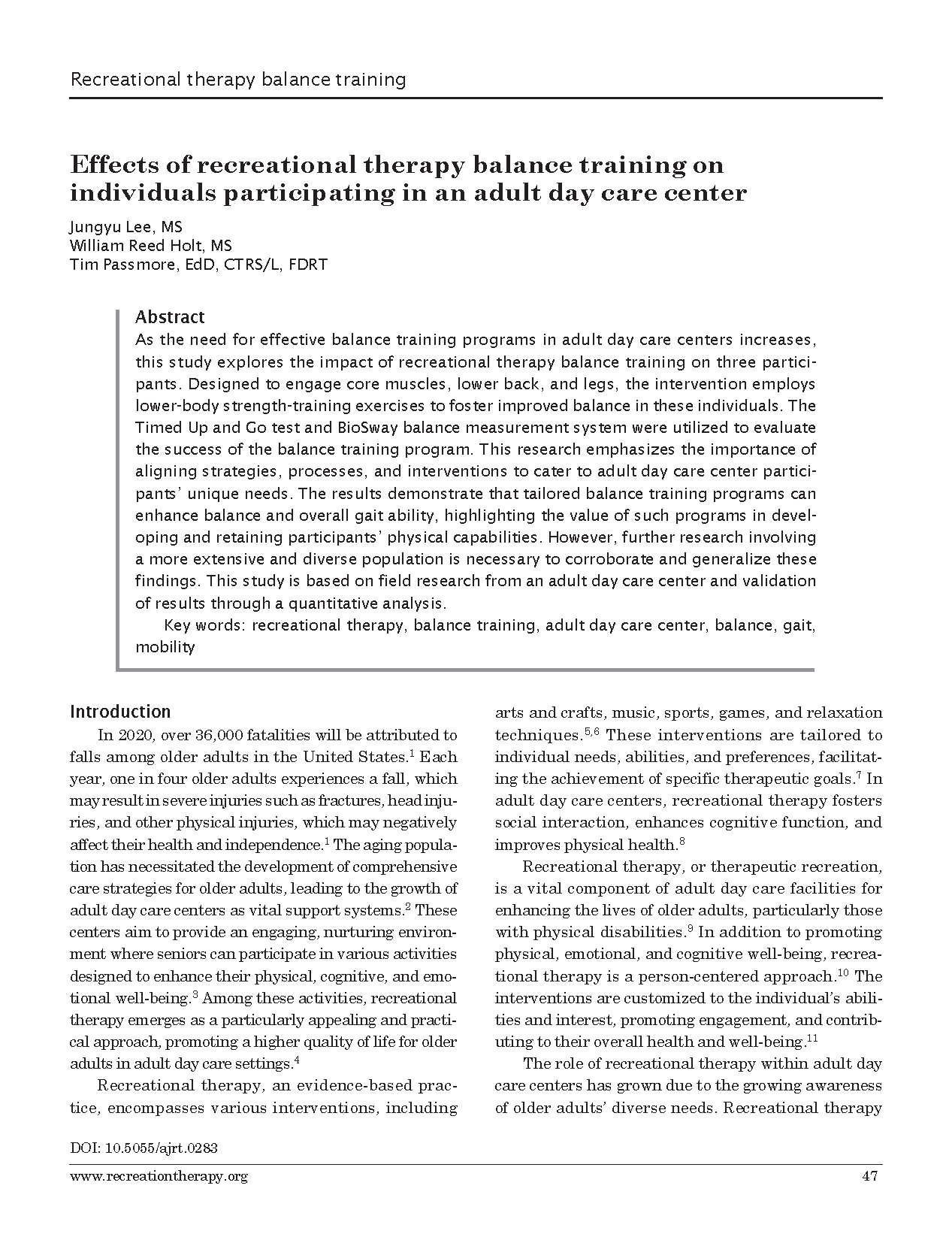Effects of recreational therapy balance training on individuals participating in an adult day care center
DOI:
https://doi.org/10.5055/ajrt.0283Keywords:
recreational therapy, balance training, adult day care center, balance, gait, mobilityAbstract
As the need for effective balance training programs in adult day care centers increases, this study explores the impact of recreational therapy balance training on three participants. Designed to engage core muscles, lower back, and legs, the intervention employs lower-body strength-training exercises to foster improved balance in these individuals. The Timed Up and Go test and BioSway balance measurement system were utilized to evaluate the success of the balance training program. This research emphasizes the importance of aligning strategies, processes, and interventions to cater to adult day care center participants’ unique needs. The results demonstrate that tailored balance training programs can enhance balance and overall gait ability, highlighting the value of such programs in developing and retaining participants’ physical capabilities. However, further research involving a more extensive and diverse population is necessary to corroborate and generalize these findings. This study is based on field research from an adult day care center and validation of results through a quantitative analysis.
References
Centers for Disease Control and Prevention: Older adult fall prevention: CDC’s injury center uses data and research to save lives. 2022. Available at https://www.cdc.gov/falls/pdf/CDC-DIP_At-a-Glance_Falls_508.pdf. Accessed August 1, 2023.
Gaugler JE, Jarrott SE, Zarit SH, et al.: Adult day service use and reductions in caregiving hours: Effects on stress and psychological well-being for dementia caregivers. Int J Geriat Psychiatry. 2002; 18(1): 55-62. DOI: 10.1002/gps.772.
Fields NL, Anderson KA, Dabelko-Schoeny H: The effectiveness of adult day services for older adults. J Appl Gerontol. 2012; 33(2): 130-163. DOI: 10.1177/0733464812443308.
Giné-Garriga M, Roqué-Fíguls M, Coll-Planas L, et al.: Physical exercise interventions for improving performance-based measures of physical function in community-dwelling, frail older adults: A systematic review and meta-analysis. Arch Phys Med Rehabil. 2014; 95(4): 753-769.e3. DOI: 10.1016/j.apmr.2013.11.007.
Stumbo NJ, Wardlaw B: Facilitation of Therapeutic Recreation Services: An Evidence-Based and Best Practice Approach to Techniques and Processes. Champaign, IL: Sagamore-Venture Publishing, 2011.
Richeson NE, Kemeny B: Recreational Therapy for Older Adults. Champaign, IL: Sagamore-Venture Publishing, 2019.
Anderson LS, Heyne LA: Flourishing through leisure and the upward spiral theory of lifestyle change. Ther Rereat J. 2016; 50(2). DOI: 10.18666/trj-2016-v50-i2-7333.
Genoe MR, Dupuis SL: The role of leisure within the dementia context. Dementia. 2012; 13(1): 33-58. DOI: 10.1177/1471301212447028.
Fitzsimmons S, Buettner LL: A therapeutic cooking program for older adults with dementia: Effects on agitation and apathy. Am J Recreat Ther. 2003; 2(4): 23-23.
Fazio S, Pace D, Flinner J, et al.: The fundamentals of person- centered care for individuals with dementia. Gerontologist. 2018; 58(1): S10-S19. DOI: 10.1093/geront/gnx122.
Stumbo NJ, Peterson CA: Therapeutic Recreation Program Design: Principles and Procedures. San Francisco, CA: Pearson/Benjamin-Cummings, 2009.
Carter MJ, Van GE: Therapeutic Recreation: A Practical Approach. Long Grove, IL: Waveland Press, Inc., 2020.
Ambrose AF, Paul G, Hausdorff JM: Risk factors for falls among older adults: A review of the literature. Maturitas. 2013; 75(1): 51-61. DOI: 10.1016/j.maturitas.2013.02.009.
Tinetti ME, Kumar C: The patient who falls. JAMA. 2010; 303(3): 258. DOI: 10.1001/jama.2009.2024.
Brandt AB, Passmore T, Bateman M, et al.: Effects of a community-based recreational therapy balance exercise program for individuals with Parkinson’s disease. Am J Recreat Ther. 2022; 21(2): 33-41. DOI: 10.5055/ajrt.2022.0261.
Lesinski M, Hortobágyi T, Muehlbauer T, et al.: Effects of balance training on balance performance in healthy older adults: A systematic review and meta-analysis. Sports Med. 2015; 45(12): 1721-1738. DOI: 10.1007/s40279-015-0375-y.
Orr R, Raymond J, Singh MF: Efficacy of progressive resistance training on balance performance in older adults. Sports Med. 2008; 38(4): 317-343. DOI: 10.2165/00007256-200838040-00004.
Sherrington C, Fairhall N, Wallbank G, et al.: Exercise for preventing falls in older people living in the community: An abridged Cochrane systematic review. Br J Sports Med. 2019; 54(15): 885-891. DOI: 10.1136/bjsports-2019-101512.
Sherrington C, Michaleff ZA, Fairhall N, et al.: Exercise to prevent falls in older adults: An updated systematic review and meta-analysis. Br J Sports Med. 2016; 51(24): 1750-1758. DOI: 10.1136/bjsports-2016-096547.
Granacher U, Muehlbaue T, Zahner L, et al.: Comparison of traditional and recent approaches in the promotion of balance and strength in older adults. Sports Med. 2011; 41: 377-400.
Karinkanta S, Heinonen A, Sievänen H, et al.: A multicomponent exercise regimen to prevent functional decline and bone fragility in home-dwelling elderly women: Randomized, controlled trial. Osteoporos Int. 2006; 18(4): 453-462. DOI: 10.1007/s00198-006-0256-1.
Verghese J, Annweiler C, Ayers E, et al.: Motoric cognitive risk syndrome: Multicountry prevalence and dementia risk. Neurology. 2014; 83(8): 718-726. DOI: 10.1212/WNL.0000000000000717.
Beauchet O, Fantino B, Allali G, et al.: Timed up and go test and risk of falls in older adults: A systematic review. J Nutr Health Aging. 2011; 15: 933-938.
Biodex Medical Systems: BioSway™|Biodex. n.d. Updated 2023. Available at http://www.biodexrehab.com/physical-medicine/products/balance/biosway-portable.html. Accessed August 1, 2023.
Arnold BL, Schmitz RJ: Examination of balance measures produced by the Biodex stability system. PubMed. 1998; 33(4): 323-327.
Sieri T, Beretta G: Fall risk assessment in very old males and females living in nursing homes. Disabil Rehabil. 2004; 26(12): 718-723. DOI: 10.1080/09638280410001704304.
Viccaro LJ, Perera S, Studenski SA: Is Timed Up and Go better than gait speed in predicting health, function, and falls in older adults? J Am Geriatr Soc. 2011; 59(5): 887-892. DOI: 10.1111/j.1532-5415.2011.03336.x.
Shumway-Cook A, Brauer S, Woollacott M: Predicting the probability for falls in community-dwelling older adults using the Timed Up & Go Test. Phys Ther. 2000; 80(9): 896-903. DOI: 10.1093/ptj/80.9.896.
Mancini M, Horak FB: The relevance of clinical balance assessment tools to differentiate balance deficits. Eur J Phys Rehabil Med. 2010; 46(2): 239-248.
Biau DJ, Kernéis S, Porcher R: Statistics in brief: The importance of sample size in the planning and interpretation of medical research. Clin Orthop Relat Res. 2008; 466: 2282-2288.

Published
How to Cite
Issue
Section
License
Copyright 2000-2025, Weston Medical Publishing, LLC and American Journal of Recreation Therapy. All Rights Reserved.

